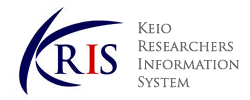-
Affiliation
-
Faculty of Science and Technology, Department of Applied Chemistry ( Yagami )
-
Position
-
Associate Professor
-
Related Websites

KEIO RESEARCHERS INFORMATION SYSTEM |
Details of a Researcher
このページはJavascriptを使用しています。すべての機能を使用するためにはJavascript を有効にする必要があります。
Serizawa, Nobuyuki
|
|
|
Central Research Institute of Electric Power Industry, Materials Science Research Laboratory
Keio University, Faculty of Science and Technology, Department of Applied Chemistry
University, Graduated
Keio University, Graduate School of Science and Technology, School of Science for Open and Environmental Systems
Graduate School, Completed, Master's course
Keio University, Graduate School of Science and Technology, School of Integrated Design Engineering
Graduate School, Completed, Doctoral course
博士(工学), 慶應義塾大学大学院, Coursework
水晶振動子電極による局所物性のその場測定を組み合わせたイオン液体中における金属の電気化学的析出・溶解に関する研究
Plating
Ionic liquids
Energy conversion & storage
Electrochemistry
Battery
イオン液体の実用展開に向けた最新動向
芹澤信幸,片山 靖, シーエムシー出版, 2022.08
Scope: イオン液体中におけるレドックス反応と電池への応用, Contact page: 106-113
Tachikawa N., Serizawa N., Katayama Y., Next Generation Batteries: Realization of High Energy Density Rechargeable Batteries, 2021.01
Design and New Energy Application of Ionic Liquids
Seki Shiro, Ono Shimpei, Serizawa Nobuyuki, Umebayashi Yasuhiro, Tsuzuki Seiji, Ueno Kazuhide, Watanabe Masayoshi, The Royal Society of Chemistry, 2018.09
Serizawa N., Kuwahara S., Li X., Katayama Y.
Journal of the Electrochemical Society 172 ( 4 ) 2025.04
ISSN 00134651
Katayama Y., Okazaki S., Serizawa N.
Electrochemistry 93 ( 6 ) 2025
ISSN 13443542
Serizawa N., Katayama Y.
Bunseki Kagaku 74 ( 9 ) 529 - 541 2025
ISSN 05251931
Sho Okazaki, Nobuyuki Serizawa, Yasushi Katayama
Electrochemistry ((公社)電気化学会) 92 ( 4 ) 043006 2024.04
Research paper (scientific journal), Joint Work, Accepted, ISSN 13443542
Electrode Reactions of Copper Species in a Bis(fluorosulfonyl)amide Ionic Liquid
Nobuyuki Serizawa, Takumi Hisada, Yasushi Katayama
Electrochemistry ((公社)電気化学会) 92 ( 4 ) 043009 2024.04
Research paper (scientific journal), Joint Work, Lead author, Corresponding author, Accepted, ISSN 13443542
Electropolishing and the Mass Transfer During the Electrochemical Anodic Dissolution of Metals in Ionic Liquids
Nobuyuki Serizawa, Yasushi Katayama
Journal of the Surface Finishing Society of Japan 73 ( 7 ) 353 - 358 2022.07
Article, review, commentary, editorial, etc. (scientific journal), Joint Work, Lead author, ISSN 0915-1869
アドミッタンス解析法を用いた電気化学水晶振動子マイクロバランス測定
芹澤 信幸, 片山 靖
電気化学 89 292 - 298 2021.09
Article, review, commentary, editorial, etc. (scientific journal), Joint Work
イオン液体中における金属電析と金属ナノ粒子の電解生成
芹澤 信幸,片山 靖
電気化学 88 ( 2 ) 121 - 128 2020.06
Article, review, commentary, editorial, etc. (scientific journal), Joint Work
電気化学QCMによるイオン液体中における金属析出・溶解反応の解析
Nobuyuki Serizawa, Yasushi Katayama
表面技術 69 ( 1 ) 10 - 15 2018.01
Article, review, commentary, editorial, etc. (scientific journal), Joint Work
イオン液体を用いた電気化学デバイスの研究・開発
関 志朗,芹澤信幸,小野新平
化学工業 64 ( 2 ) 17 - 22 2013.02
Article, review, commentary, editorial, etc. (trade magazine, newspaper, online media), Joint Work
水晶振動子測定法を用いた動的電気化学界面における電解液の 局所物性の解析
芹澤信幸,片山 靖
[Domestic presentation] 日本分析化学会 第74回年会 (北海道大学工学部) ,
Oral presentation (invited, special), 日本分析化学会
水晶振動子測定法およびレドックスプローブ法を用いた電極/電解液界面の解析
芹澤信幸,片山 靖
[Domestic presentation] 第426回電池技術委員会 (東京科学大学) ,
Oral presentation (invited, special), 電気化学会電池技術委員会
「基礎電気化学」アプローチによる 活イオンリッチ反応場の追跡
芹澤信幸
[Domestic presentation] 活イオン液体の科学公開シンポジウム (京都大学東京オフィス) ,
Symposium, workshop panel (nominated), 科研費学術変革領域B 「活イオン液体の科学」
Nobuyuki Serizawa, Suguru Kuwahara, Xiaoyi Li and Yasushi Katayama
[International presentation] PRiME2024 (Honolulu) ,
Oral presentation (general)
Kentaro Yoneda, Nobuyuki Serizawa, and Yasushi Katayama
[International presentation] PRiME2024 (Honolulu) ,
Poster presentation
資源循環に向けたイオン液体中における金属の電気化学的アノード溶解反応の解析
基盤研究(C), Principal investigator
「基礎電気化学」アプローチによる活イオンリッチ反応場の追跡
学術変革領域研究(B), Principal investigator
Electrochemical quartz crystal microbalance measurements of the electrode reactions in lithium secondary batteries
MEXT,JSPS, Grant-in-Aid for Scientific Research, Grant-in-Aid for Early-Career Scientists , Principal investigator
功労賞
2022.03, 電気化学会関東支部
Type of Award: Award from Japanese society, conference, symposium, etc.
溶融塩奨励賞
2020.11, 電気化学会 溶融塩委員会, リチウムイオンを含むアミド系イオン液体 中におけるニトロキシラジカルの酸化還元反応
Type of Award: Award from Japanese society, conference, symposium, etc.
TAKUMI賞
2013.11, 電力中央研究所, 水晶振動子の新たな利用法の開拓:電極近傍の電解質イオン液体のダイナミクス解析手法の開発
Type of Award: Other
国際会議論文発表奨励賞
2008.12, 慶應義塾大学大学院理工学研究科, EQCM measurement of Ag deposition in an amide-type room-temperature ionic liquid
Type of Award: Keio commendation etc.
ポスター賞
2008.03, 社団法人 電気化学会, イミド系室温イオン液体中におけるAg(I)/Ag電極反応
Type of Award: Award from Japanese society, conference, symposium, etc.
SEMINAR IN APPLIED CHEMISTRY
2025
NANO SCALE SCIENCE JOINT SEMINAR
2025
MATERIAL DESIGN SCIENCE JOINT SEMINAR
2025
LABORATORIES IN SCIENCE AND TECHNOLOGY
2025
LABORATORIES IN APPLIED CHEMISTRY C
2025
応用化学実験C
Keio University
Autumn Semester, Laboratory work/practical work/exercise
理工学基礎実験
Keio University
Spring Semester, Laboratory work/practical work/exercise
表面技術協会,
イオン液体研究会,
電池技術委員会,
溶融塩委員会,
The lectrochemical Society,
事務局長, 電気化学会溶融塩委員会
事務局長, 第62回電池討論会実行委員会
会誌編集幹事, (公社)電気化学会
会誌編集副幹事, (公社)電気化学会
代議員, 電気化学会